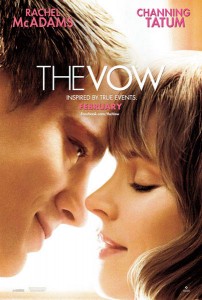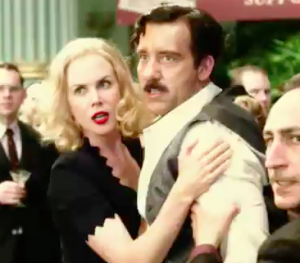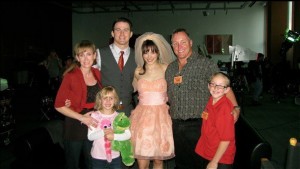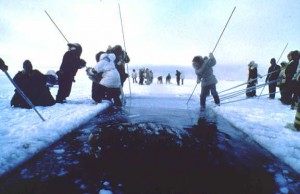“The Vow,” starring Channing Tatum and Rachel McAdams, is based on the real-life story of Kim and Krickett Carpenter, who wrote a book about their experience after a traumatic brain injury shortly after their wedding erased all of Krickett’s memory of the previous 18 months. She did not remember being married and she did not remember even having met her husband. He had to make her fall in love with him all over again. Kim Carpenter spoke to me about their book, The Vow: The True Events that Inspired the Movie and the film it inspired, and Krickett joined in at the end to share her favorite Bible verse. I can’t think of a better tribute to Valentine’s Day than hearing the real story from this inspiring couple.
and the film it inspired, and Krickett joined in at the end to share her favorite Bible verse. I can’t think of a better tribute to Valentine’s Day than hearing the real story from this inspiring couple.
What do you think of the movie?
We enjoyed it! Obviously, there’s some artistic license that isn’t true to the entire story. Trying to tell a story of 20 years in 103 minutes is extremely challenging. They gravitate toward the emotion of the audience but it is very inspiring which is what we hope the real message will be, the real impact on the viewer. 
Our biggest concern is that my wife’s parents are very devout in their faith and have been happily married for over 50 years. Between my parents and Krickett’s parents there’s over 100 anniversaries that have been celebrated. So the portrayal of her parents was not like our story. But Rachel and Channing did an outstanding job in studying us, our behavior, our habits, interviews we’ve done over the years. And I don’t think you could come up with better chemistry between two actors. They created a true sense of relationship on the silver screen, so many similarities to us and to the events we went through. Our heart is in our book. The end of the movie draws people to want to know more and the people who read the book are drawn to wanting to see the movie.
Did Krickett move back in with her parents as the character does in the movie? Did you ever give up?
Yes, they felt it was in her best interests at the time and I went home to try to achieve some sense of normalcy but there was never any separation. She was in a rehab facility in her home town. We never gave up on one another. She had every right to; she had no recollection of me, meeting me, dating me, nothing. At my weakest and lowest point I did have the feeling that this can’t work. As Channing portrayed in the film, I was at that point. I thought, “If that’s going to be the case, I’m going to stay with her until first she can take care of herself and have a good quality of life and second that she can be with it enough to look me in the eye and tell me it just wasn’t going to happen.” But the Lord had different ideas about this. Our faith is very important to us and the overall experience is something we will always cherish. It taught us that the little things don’t matter. It made us different people.
One thing that was accurate in the movie is that first time you fell in love it was immediate but the second time it had to build up slowly over a long period of time. What was that like?
Comas are depicted in a strange way in Hollywood. It’s a level of consciousness. You can walk and talk and still be charted as being in a coma. That process was drawn out. To be quite honest, it took more than three years. We had to accept that we needed a new beginning, a start over. There’s not going to be any memory. There’s not going to be any recovery in that area. So let’s move on and build new memories and make new memories rather than being obsessed with trying to bring back what was.
So you started from the beginning?
We dated again. We got engaged again on Valentine’s day of 1996 and on May 25 of that year we had a second wedding.
What do your children think of your story?
To have a book written that readers see all over the world is awesome for us. To have a movie made about us because we maintained our vows is extraordinary. But our children are the true blessings of our vows. If we had not stayed together, they would have never had a chance at life. I’m excited about it all but I’m especially excited that our children get to share this experience, travel, meet the director, doing interviews.
Parents in a family structure spend their lives trying to teach their kids to do the right thing and to be honest. It’s one thing to listen to a parent’s lecture about it and another thing to use it as a lesson for them to learn that will forever be carried on in their life and that’s priceless. They are seeing the rewards of doing the right thing. It’s unfortunate that in our society doing the things you said you would do is unusual enough to make a movie about it. But we are glad the world has grasped onto the story. “Unbelievable” and “amazing” are the words we hear but we just did what we said we would do. In wedding ceremonies, they say “‘Til death do you part,” and 50 years ago that was what it meant, the death of your soulmate. But today’s society accepts the death of a marriage for the smallest of issues. That crumbles the foundation of society. Our biggest prayer is that we hope this move will inspire people, whether they’re married or not, to doing the right thing, making a commitment, look at life in a great way, making good decisions. In the institution of marriage, we hope it gives them a framework to provide a sense of direction and inspiration to start or save a marriage.
Was your faith tested?
I was bitter at the Lord. How could this happen? I was on top of the world. I was bulletproof. I told my wife, “I can never be humbled.” But I met a man who lost his leg and then watched his daughter drown because he could not swim to save her. I met a family who lost three daughters in three years. It put things into perspective at how blessed we are. Those kinds of life experiences are all parts of lessons we learn.
Do you have a favorite Bible verse?
2 Corinthians 5:7 “For we walk by faith, not by sight.” And Krickett?
Krickett Carpenter: Mine is “I can do all things by Christ who strengthens me.” Philippians 4:13 . That is what I really held onto. He can give you strength through all things. This was just one thing of all the trials that could happen to people. I clung to those verses because God’s word is true and he’s a faithful, loving God.
 HBO’s new movie “Hemingway and Gellhorn,” premiering this week, stars Clive Owen and Nicole Kidman and is directed by Philip Kaufman (“The Right Stuff,” “The Unbearable Lightness of Being”). Today Ernest Hemingway is revered as one of the formost authors of the 20th century for his spare, masculine stories like For Whom the Bell Tolls, The Sun Also Rises, and A Farewell to Arms. Martha Gellhorn, who became his third wife, was a pioneering journalist and war correspondent who covered armed conflict around the world for five decades. Some of her writing is collected in The Face of War
HBO’s new movie “Hemingway and Gellhorn,” premiering this week, stars Clive Owen and Nicole Kidman and is directed by Philip Kaufman (“The Right Stuff,” “The Unbearable Lightness of Being”). Today Ernest Hemingway is revered as one of the formost authors of the 20th century for his spare, masculine stories like For Whom the Bell Tolls, The Sun Also Rises, and A Farewell to Arms. Martha Gellhorn, who became his third wife, was a pioneering journalist and war correspondent who covered armed conflict around the world for five decades. Some of her writing is collected in The Face of War. She wrote a memoir called Travels with Myself and Another and there is a biography by Caroline Moorehead called Gellhorn: A Twentieth-Century Life.
. Hemingway committed suicide in 1961. Gellhorn, blind and ill, also committed suicide, in 1998.



